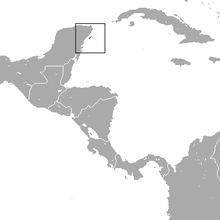TheCozumel thrasher(Toxostoma guttatum) is abirdfrom the mockingbirdfamily(Mimidae), which isendemicto the island ofCozumeloff theYucatán Peninsula,Mexico.It is believed to be the most critically endangered species of bird in Mexico – if it indeed still exists, which is probable but not certain.[2]
| Cozumel thrasher | |
|---|---|

| |
| Scientific classification | |
| Domain: | Eukaryota |
| Kingdom: | Animalia |
| Phylum: | Chordata |
| Class: | Aves |
| Order: | Passeriformes |
| Family: | Mimidae |
| Genus: | Toxostoma |
| Species: | T. guttatum
|
| Binomial name | |
| Toxostoma guttatum (Ridgway,1885)
| |

| |
| Cozumel thrasher range | |
This bird is closely related to thelong-billedandbrownthrashers. It has been generally described as shy, but there have been descriptions to the contrary. It was once abundant throughout Cozumel before two hurricanes greatly affected its numbers.Invasive speciesare also thought to have impacted the population of the thrasher.
Taxonomy
editThe Cozumel thrasher was first described asHarporhynchus guttatusbyRobert Ridgwayin 1885.[3][4]It has been described as a subspecies to its relative thelong-billed thrasher(Toxostoma longirostre), but was considered a separate species when it was determined in a 1998 study that it differed genetically more than five percent from both the long-billed andbrown thrashers(T. rufum).[5]In the same study it was determined to be the basal member of therufumgroup ofToxostomathrashers.[5]The bird ismonotypic.[3]
Description
editThe thrasher is 21.5 to 24 centimetres (8.5 to 9.4 in) in length. The adult has a browncrown,back, shoulders, andrumpthat becomes more red in its tint on its lower back and rump.Greater and lesser covertsare a warm brown with concealed white tips, preceded with a black bar.Primariesandsecondariesare grayish-brown with warm rufous-brown outer webs. Therectricesare also have a warm brown color. Theloresand ear-coverts are a mottled grey brown. The chin and throat are an off-white color with a blackish partial malar stripe. The chest is a buffy-white in color with stark black teardrop shaped spots. The belly is off-white, and theflankshave larger black spots. Itsventis buffy and an underwing that is buffy-white with darker markings. Theirisis yellow, thebillis grayish-brown, and the legs are brown with a dull tint. Juveniles'plumagehave not been recorded, but presumably is similar in development to adulthood like the long-billed and brown thrasher.[3]
Similar species
editThe Cozumel thrasher is similar in appearance to the long-billed thrasher (Toxostoma longirostre,26.5–29 centimetres or 10.4–11.4 inches in length), but is smaller, darker in color, has a blacker bill, and the markings are more sharply defined.[6]No other thrasher species coexist on the island, but the Cozumel thrasher may be confused with the migratorywood thrush(Hylocichla mustelina). The wood thrush differs in lacking wing bars, a shorter beak, and a different shape.[3]
Distribution and habitat
editThe distribution of the thrasher is restricted toIsla Cozumelwhich is 45 km long and 20 km wide.[3]
The habitat preferences for the thrasher is thought to be in low and medium deciduous and semi-deciduous forests.[3]It may have once been most abundant in forest edges adjacent to clearings.[6]
Behavior and ecology
editThe thrasher is predominately terrestrial and elusive and as with all members of the genusToxostoma,it may resort to running instead of flying when startled. OrnithologistsLudlow GriscomandRaymond A. Paynter, Jr.had noted its secretive behavior, butJames Bonddid not.[6]
The song is described as a rich varied warbling, slightly scratchy with little repetition.[3]Bond described its alarm note being similar to the brown thrasher.[6]
Status
editThe numbers of this bird declined rapidly whenHurricane Gilberthit this island on September 14, 1988. Until it was sighted in June 2004, this bird had last been seen in 1995, the same year thatHurricane Roxannehit Cozumel on October 11, and it was widely believed to have becomeextinct.[2]
It is still unclear what damage the impact of HurricanesEmilyandWilmain 2005 caused; it seems that the bird was not found anymore during a survey in December 2006.[7]
Inquiry from the local population had suggested that the species would likely be encountered near theMayanruins ofSan Gervasio.[3]
The last – unconfirmed – sightings were in April 2006, where an apparentT. guttatumwas sighted at theCozumel Golf Club;in October and December 2007, thrashers were also seen but could not be reliably identified asT. guttatum.Relocation efforts continue; though at least a few birds seem to survive, the continuing existence of this species had not been verified as of January 2008.[8]
Some scientists believe that other factors must have contributed to the bird's decline, because the Cozumel thrasher likely survived hurricanes for millennia.[8]Introduced species,including predatoryboa constrictors—which were released on the island in 1971 and are now abundant—may also have had a detrimental effect.[9]
Footnotes
edit- ^BirdLife International (2020)."Toxostoma guttatum".IUCN Red List of Threatened Species.2020:e.T22711105A179828104.doi:10.2305/IUCN.UK.2020-3.RLTS.T22711105A179828104.en.Retrieved11 November2021.
- ^abENS (2004)
- ^abcdefghBrewer, David (2001).Wrens, Dippers, and Thrashers.Yale University Press. pp.232–33.ISBN978-0-300-09059-8.
- ^The Ibis, Volume III, Fifth Series.1885. p. 320.
- ^abZink, Robert M.; Dittmann, Donna L. (1999)."Evolutionary Patterns of Morphometrics, Allozymes, and Mitochondrial DNA in Thrashers (GenusToxostoma) "(PDF).The Auk.116(4):1021–38.doi:10.2307/4089682.JSTOR4089682.
- ^abcd"El cuitlacoche de cozumel: The endemic thrasher of Cozumel Island".Villanova University.Retrieved8 March2015.
- ^Surfbird News (2006)
- ^abCurry (2008)
- ^Martínez-Morales, Miguel Angel; Cuarón, Alfredo D. (July 1999). "Boa constrictor, an introduced predator threatening the endemic fauna on Cozumel Island, Mexico".Biodiversity and Conservation.8(7):957–963.doi:10.1023/A:1008815004072.S2CID19655051.
References
edit- Curry, Robert L. (2007):El cuitlacoche de cozumel- The endemic thrasher of Cozumel Island.Version of 2008-JAN-28. Retrieved 2008-FEB-12.
- Environment News Service (2004):The Cozumel Thrasher: One Bird Away From Extinction.Includes habitat photo. Version of 2004-JUL-09. Retrieved 2007-FEB-08.
- Surfbird News (2006):Recently Discovered Species Gain Protection.Version of 2006-DEC-28. Retrieved 2008-FEB-12.
External links
edit- BirdLife International:Cozumel Thrasher Species Factsheet.Retrieved 2007-FEB-08.
